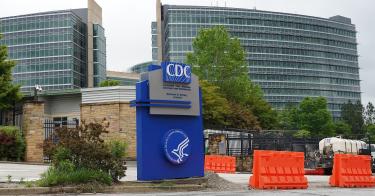When the levees broke under Hurricane Katrina, the Army Corps of Engineers was roasted for spending billions and still failing to protect Americans. So where's the outrage over the latest epic governmental fail—this one by the Centers for Disease Control and Prevention?
The federal agency with primary responsibility for handling infectious diseases, the CDC uses an antiquated system to collect information essential to fighting the coronavirus. Medical workers literally phone or fax in their data. And when they do, it's not the data we need.
The CDC employs thousands of experts and has been around for 76 years. Yet its COVID-19 data pales in comparison to what's available on websites that didn't even exist a few months ago. One of these, The Atlantic's COVID Tracking Project, was launched in March—the same month Congress gave the CDC $1 billion to collect the same data.
Multiple congresses and administrations have tried to drag the CDC into the 21st century, to no avail. Since 2006, the CDC has ignored four separate laws requiring it to build a modern, efficient system for collecting information to combat disease.
The Government Accountability Office has twice reprimanded the CDC for its impudence. A decade ago, it warned prophetically that "the nation will lack an effective tool for ensuring that public health situational awareness capabilities have been established." Yet the CDC still has not acted.
When Congress required the centers to establish a modernized system in 2006, it gave them a 2008 deadline. Yet 12 years on, the CDC still has not stitched together more than 100 reporting systems into a cohesive dashboard. This is blowing our country's budget, and those of many states.
Compounding the problem is the fact that CDC reporting is usually a one-way street: Health care workers report to public health officials, but get little information back. The result: Clinical knowledge, patient data and best practices for treating COVID-19 aren't being shared in real time for hospitals and policymakers to use. That is costing lives, as well as trillions of dollars.
To succeed where the CDC has failed, the Department of Health and Human Services must do four things.
First, it must identify, prioritize, and standardize the key data needed to ensure a robust, informed response to COVID-19, opioid abuse and other public health threats. For example, it is essential to collect timely information on hospitalizations and mortality, the age and comorbidities of patients and total net active cases. It is scandalous that this data is not uniformly defined and reported.
To increase understanding of which populations are most susceptible to the contagion, the data must identify confirmed cases by race, ethnicity, disability, and income levels. it must also be geographically specific, so policymakers can identify hotspots and implement targeted mitigation strategies.
Second, data must be collected within normal clinical workflows. Front-line doctors don't have time to file separate reports on top of the claims data they submit to insurers, yet that's precisely what they have to do today. Almost all hospitals—and 75% of physician offices—now use electronic systems (created with a $40 billion investment from federal taxpayers) to file insurance claims. Yet they are forced to reenter data by hand when they report to public health agencies. HHS should have this data collected automatically from a doctor's electronic health record or by adopting Medicare Part D's approach of gleaning data directly from insurance claims.
Third, information must be shared in real-time with medical professionals. Reporting should be a two-way street that informs public health decision-making and clinical care. This requires national, interoperable networks that can be accessed by labs, hospitals, doctors, nurses, pharmacists and public health officials. The end goal is not to create a federal vault of new data, but to constantly update those on the frontlines with useful information.
The CDC lacks the internal expertise to do this. HHS should immediately issue a contract to build the system. In the interim, HHS could direct the CDC to start hosting calls for front-line clinicians to learn from each other as they find new ways to treat the virus.
Finally, the network must contain strong privacy protections. Data transmitted to the federal government should be de-identified. Those who misuse or improperly disclose personal health information must be subject to stiff civil and criminal penalties.
The CDC's long-standing failure to modernize its data systems is intolerable. Things must change, and quickly, to improve our understanding of the pandemic and prepare us for future crises.
This piece originally appeared in The Sacramento Bee



